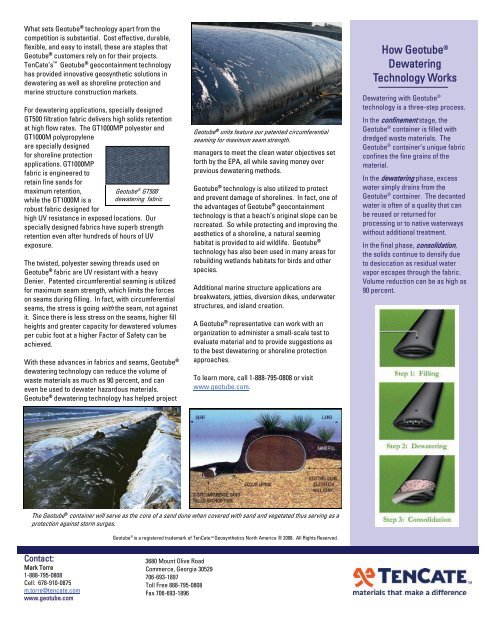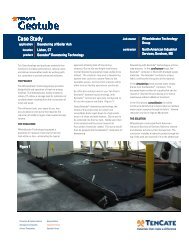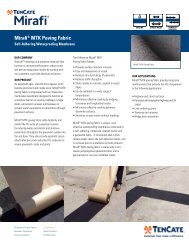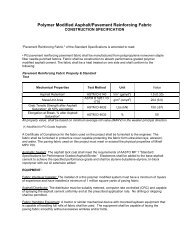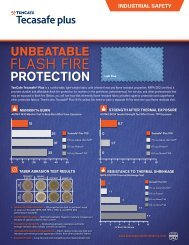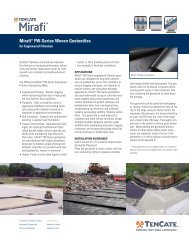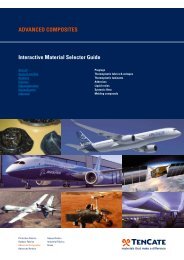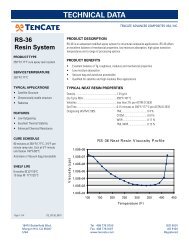Download PDF - TenCate
Download PDF - TenCate
Download PDF - TenCate
Create successful ePaper yourself
Turn your PDF publications into a flip-book with our unique Google optimized e-Paper software.
What sets Geotube ® technology apart from the<br />
competition is substantial. Cost effective, durable,<br />
flexible, and easy to install, these are staples that<br />
Geotube ® customers rely on for their projects.<br />
<strong>TenCate</strong>’s Geotube ® geocontainment technology<br />
has provided innovative geosynthetic solutions in<br />
dewatering as well as shoreline protection and<br />
marine structure construction markets.<br />
For dewatering applications, specially designed<br />
GT500 filtration fabric delivers high solids retention<br />
at high flow rates. The GT1000MP polyester and<br />
GT1000M polypropylene<br />
are specially designed<br />
for shoreline protection<br />
applications. GT1000MP<br />
fabric is engineered to<br />
retain fine sands for<br />
maximum retention,<br />
Geotube<br />
while the GT1000M is a<br />
robust fabric designed for<br />
high UV resistance in exposed locations. Our<br />
specially designed fabrics have superb strength<br />
retention even after hundreds of hours of UV<br />
exposure.<br />
® GT500<br />
dewatering fabric<br />
The twisted, polyester sewing threads used on<br />
Geotube ® fabric are UV resistant with a heavy<br />
Denier. Patented circumferential seaming is utilized<br />
for maximum seam strength, which limits the forces<br />
on seams during filling. In fact, with circumferential<br />
seams, the stress is going with the seam, not against<br />
it. Since there is less stress on the seams, higher fill<br />
heights and greater capacity for dewatered volumes<br />
per cubic foot at a higher Factor of Safety can be<br />
achieved.<br />
With these advances in fabrics and seams, Geotube ®<br />
dewatering technology can reduce the volume of<br />
waste materials as much as 90 percent, and can<br />
even be used to dewater hazardous materials.<br />
Geotube ® dewatering technology has helped project<br />
Contact:<br />
Mark Torre<br />
1-888-795-0808<br />
Cell: 678-910-0875<br />
m.torre@tencate.com<br />
www.geotube.com<br />
3680 Mount Olive Road<br />
Commerce, Georgia 30529<br />
706-693-1897<br />
Toll Free 888-795-0808<br />
Fax 706-693-1896<br />
Geotube ® units feature our patented circumferential<br />
seaming for maximum seam strength.<br />
managers to meet the clean water objectives set<br />
forth by the EPA, all while saving money over<br />
previous dewatering methods.<br />
Geotube ® technology is also utilized to protect<br />
and prevent damage of shorelines. In fact, one of<br />
the advantages of Geotube ® geocontainment<br />
technology is that a beach’s original slope can be<br />
recreated. So while protecting and improving the<br />
aesthetics of a shoreline, a natural seeming<br />
habitat is provided to aid wildlife. Geotube ®<br />
technology has also been used in many areas for<br />
rebuilding wetlands habitats for birds and other<br />
species.<br />
Additional marine structure applications are<br />
breakwaters, jetties, diversion dikes, underwater<br />
structures, and island creation.<br />
A Geotube ® representative can work with an<br />
organization to administer a small-scale test to<br />
evaluate material and to provide suggestions as<br />
to the best dewatering or shoreline protection<br />
approaches.<br />
To learn more, call 1-888-795-0808 or visit<br />
www.geotube.com.<br />
The Geotube ® container will serve as the core of a sand dune when covered with sand and vegetated thus serving as a<br />
protection against storm surges.<br />
Geotube ® is a registered trademark of <strong>TenCate</strong> TM Geosynthetics North America ® 2008. All Rights Reserved.<br />
How Geotube ®<br />
Dewatering<br />
Technology Works<br />
Dewatering with Geotube ®<br />
technology is a three-step process.<br />
In the confinement stage, the<br />
Geotube ® container is filled with<br />
dredged waste materials. The<br />
Geotube ® container’s unique fabric<br />
confines the fine grains of the<br />
material.<br />
In the dewatering phase, excess<br />
water simply drains from the<br />
Geotube ® container. The decanted<br />
water is often of a quality that can<br />
be reused or returned for<br />
processing or to native waterways<br />
without additional treatment.<br />
In the final phase, consolidation,<br />
the solids continue to densify due<br />
to desiccation as residual water<br />
vapor escapes through the fabric.<br />
Volume reduction can be as high as<br />
90 percent.


